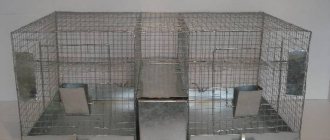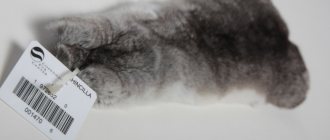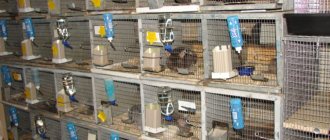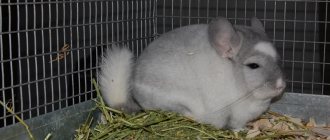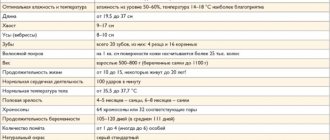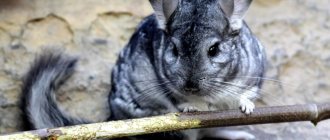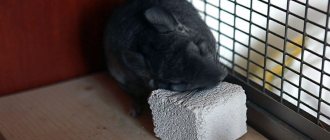Chinchillas
Chinchillas are animals that are listed in the Red Book! On many farms they are bred in order to later obtain valuable fur. These animals appeared in South America. They live in dry and rocky areas. Some of them can live up to twenty years.
Chinchillas feed mainly on plant foods and various insects. The activity of animals is highest at night. They began to be grown for valuable fur at the beginning of the 19th century. These animals can be kept both at home, as a pet, and on farms to obtain valuable fur.
The body of chinchillas reaches from 20 to 38 centimeters in length.
Pregnancy in chinchillas lasts 120 days, and then from one to six small animals can be born.
All these features need to be taken into account when choosing housing for pets.
You can have no more than two chinchillas in an apartment, but this will require a cage for them to live there. Knowing the size of the chinchilla cage, you can easily make it yourself! If your plans include the idea of having several animals, you will need a special enclosure. Here the question arises about what cage size for a chinchilla is minimal, optimal and ideal for farming.
Town
Chinchillas are animals prone to obesity, and they need active movement just like food and water. You can make chinchillas move by building them easy-to-climb routes in the “town.”
The town includes:
- running wheel for chinchillas;
- shelves fixed at different levels;
- transitions between shelves.
The variety of transitions is limited only by the imagination and skill of the chinchilla owner.
It can be:
- suspension bridges;
- tunnels;
- stairs;
- swing.
The only requirement for all these products is natural wood without paint or varnish. You can make transitions from unsanded branches of edible tree species. And change it periodically.
The role of a transition, a toy and a place to rest is simultaneously performed by a hammock for a chinchilla suspended in a display case. It is made from dense non-stretch fabric. Denim suits well. They secure it so that the chinchilla can jump into the hammock, but cannot swing it too much.
In addition to shelves and passages, the town must have a running wheel and a treadmill. The wheels are sold in pet stores and are designed for all active small animals. You need to buy a wooden or plastic one, as a metal wheel can be dangerous for a chinchilla. But you can do it yourself.
DIY chinchilla wheel
To make a wheel you will need:
- 2 sheets of plywood with a side of at least 40 cm and a thickness of at least 1 cm;
- up to 10 figured meter slats;
- automobile tension bearing;
- drill;
- drill 12 mm;
- self-tapping screws;
- 2 bolts with a diameter of 12 mm: long and short;
- screwdriver;
- washers for bolts;
- nuts for bolts;
- jigsaw
Manufacturing technology:
- Find the middle in the pieces of plywood and drill holes. Using a jigsaw, cut out 2 circles of 30 cm in diameter.
- One is left, another circle with a diameter of 25–27 cm is cut out of the other. Only a large circle will be needed from this circle.
- The slats are cut into pieces about 15 cm long. The size of the slats depends on the chinchilla. The animal must fit freely into the wheel.
- The cut slats are attached closely to the ends of the circle and the cut out circle.
- Put a washer on the long bolt, insert the bolt from the inside into the wheel, put on another washer and screw the structure with a nut.
- A hole for a bolt is drilled in the wall of the display case.
- The center of the bearing is aligned with the hole in the wall and the bearing is screwed in with self-tapping screws.
- The wheel with the bolt is inserted into the bearing and tightened with a nut from the outside of the display case.
The video shows in sufficient detail how to make a running wheel for chinchillas.
Treadmill
For chinchillas, this is an additional device, and it is easier to buy it in a store. There it can be sold as a treadmill for decorative hedgehogs. She looks like this.
Now the display case contains everything necessary for a happy life for chinchillas. All that remains is to figure out what a walking ball is.
Chinchilla ball
This is a device that a chinchilla should not have. The plastic ball transmits infrared rays very well and heats up from the inside. Chinchillas do not tolerate heat well. Half an hour in such a ball is enough for the animal to die.
In such a ball, some careless owners of small animals let them “walk” in the fresh air and eat the green grass that falls into the cracks of the ball. Juicy food is contraindicated for chinchillas. And the stress of a walk is much more harmful than being in a spacious display case.
Breeding chinchillas for fur
It will no longer be possible to breed chinchillas for fur in a simple city apartment, because a whole family of rodents will not fit in one cage. They will need a specially equipped enclosure. On farms for these animals, enclosures are installed that do not block access for males to females, because if they do not meet, offspring will not appear. The dimensions of farm cages must be no less than 163 cm by 43 cm by 200 cm. To prevent females from leaving their cages to males, a special device is attached to their necks.
These cute creatures will live comfortably in places with temperatures of about 20 degrees. The animals are very sensitive to heat and less sensitive to cold. Make sure that the air temperature does not drop below zero!
Chinchillas will not live on metal bars, so place hay or sawdust on the bottom of the cage.
Parameters for two or more animals
For two chinchillas you need a home with dimensions of at least 900x900x500 mm. To calculate the size of a cage for several rodents, the minimum size of 700x700x500 mm is multiplied by the number of animals. An excellent solution is a multi-tiered credo cage.
To make the animals comfortable during the warm season, an enclosure is placed on the balcony or in the yard. The size of such a fence is unlimited. Enclosures are frames covered with metal mesh. If the structure is placed on the street, a metal sheet must be placed at the bottom and the walls are sheathed with iron to a height of 500 mm. This will protect against the appearance of field mice and other wild animals in the enclosure, and at the same time serve as shelter from the winds. Sawdust is used as filler.
Enclosures are installed under a canopy or have a roof to protect them from rain. Such structures help out when it is not possible to place a spacious cage in the house for a family of chinchillas.
Breeding chinchillas as pets
As mentioned above, you can have chinchillas in an apartment or in a house. But it is worth remembering that it will not be possible to have more than two individuals. You will definitely need to purchase a cage for your unusual pets that will be comfortable and of a suitable size. 14-20 degrees Celsius will be the most suitable temperature for this type of rodent to live. Remember the most important thing: they absolutely cannot tolerate drafts or sunlight that falls directly on them.
Chinchillas that are bred at home very quickly get used to people and become completely tame. They will not be afraid of people. They will be very sweet, kind and friendly. But forget about the fact that they can be let out for a walk around the apartment. Rodents are natural chewers, so keep them in a cage. The size of the chinchilla cage must be chosen correctly to ensure the pet’s comfort.
Choosing a cage for chinchillas
The size of the chinchilla cage should be such that the animal easily fits in there and can live comfortably.
Many experts say that cages are most suitable for this type of animal. But in order for rodents to feel comfortable there, you need to know what size a chinchilla’s cage should be. It's not that difficult to figure this out. So, what is the optimal cage size for chinchillas?
You choose a home for the animal. And you need to select the size of a cage for chinchillas according to the animal, and not according to your taste, because the main thing is that he feels cozy and comfortable in it. The animals spend most of their lives there, so don't skimp!
In addition to the question of what size a chinchilla cage is, you also need to ask yourself what should be inside it.
First, come to the store and choose a spacious, hygienic design. The passage to the cage must be simple. Do not leave chinchillas in places where there is constant noise or in isolated areas. The animals will not be able to relax, which means they will not be able to rest either. All this will not lead to good things.
Since the animals cannot stand the sun's rays, they cannot be placed near the window. Remember: if you want to sleep at night, do not put a cage with chinchillas in the bedroom, because their greatest peak of activity is at night.
Among the cages, the most popular are the ones with a retractable tray, as they are quite easy to care for.
So, the minimum cage size for a chinchilla is 50 cm by 70 cm by 50 cm. But this is still not enough. The optimal cage size for chinchillas is 84 cm by 50 cm by 40 cm.
Having purchased housing for animals, do not rush to place them there. First, add special shelves to the cage so that the animals can run somewhere. Place a food bowl and a drinking bowl. Some chinchilla owners make a house in their cages. If you have such a desire, then buy it, it won’t hurt.
Requirements
Regardless of whether the chinchilla cage is purchased ready-made or made independently, it must meet certain standards. This will provide the pet with proper living conditions in the future. Housing should not only be comfortably decorated, dry, bright, illuminated, but also have good ventilation.
In addition, several characteristics are important for the design
Minimum size
Keeping an adult chinchilla requires a lot of space: the dimensions of the cage should not be less than 50 cm in length and width and 70 cm in height. If the cage is small, the animal’s activity will decrease and it will begin to get sick more often.
To keep several individuals, the above parameters must be multiplied by the number of animals.
This size will be quite enough for the pet to have a place to rest, eat and play.
Distance between mesh bars
To protect the animal, this figure should be no more than 20 mm. Otherwise, the “fluffies” will be able to easily get out.
Free access for cleaning
To facilitate the process of cleaning the house, the presence of a retractable tray in the design, where you can pour small shavings or sawdust, will help. If you purchase a cage with a fixed floor, then cleaning it will be difficult and inconvenient.
Today, cages for chinchillas are presented in a huge assortment, and each type differs not only in size, design, but also in price. Several cage designs are best suited for keeping this type of animal.
Showcase
It is made in large sizes and is intended for group breeding of pets. As a rule, such models are purchased by those who plan to professionally breed chinchillas. Showcases are made from various materials, but wooden construction is in particular demand.
A cage made of wood is considered environmentally friendly and looks attractive, but it must be additionally lined with dense material, otherwise pets will quickly gnaw through the walls of the structure. You can also make display cases from durable plywood and glass.
Box of twigs
This is a common type of cage that can be found in every pet store at an affordable price. Additionally, the boxes are equipped with houses, which allows you to save money on arranging housing for the animal. Such cages can be disassembled into separate parts, they are convenient to store and transport in bags. In addition, the boxes are easy to clean. The only drawback of such models is that products made from rods are not able to absorb sound.
DIY design
It can be multi-tiered, three-story, corner and wall. For more convenient operation, owners make structures on wheels using old cabinets and chests of drawers. The main advantage of such a house is that it can be assembled from any available material according to an individual design.
Most often, homemade structures are made from plywood, planks and glass, but their assembly requires some experience and time.
Choosing a cage for chinchillas on a farm
If you will breed animals in order to later obtain valuable skins from them, then the size of a standard farm cage for chinchillas should be much larger than usual. There should be special tunnels through which the male can run to the females.
The cage should also have shelves that will be used by the animal for movement. A drinking bowl and food bowl must be present. You can also put up houses, but under no circumstances should they have a bottom!
The bottom of the cage can be covered with sawdust or straw, so the animal will be much more comfortable.
Instructions for making a chinchilla cage at home with your own hands
So, before you start making the cage, you need to decide on the material. Plastic, chipboard or DVD will not work. Dirty wood infected with fungi is also not suitable. Artificial materials are also unsuitable for making cages for animals such as chinchillas. When making a cage, pay attention to various small items, such as bolts, nuts, and so on. They must be securely fastened. They are small in size, which means that animals can easily swallow them, which is very bad.
So, the cell itself, or rather its frame, is made of aluminum. The side walls are made of metal mesh, and the pallet is made of steel sheets. Other materials are used for finishing inside the cage.
Once the structure is ready, you can fill the bottom with sawdust or straw for the chinchilla’s comfort. They will have to be changed daily, but in parts, and every week - completely.
Housing dimensions for one rodent
The chinchilla should have a large cage in which it can move freely. For one rodent, the minimum cage dimensions are 700x700x500 mm. It’s even better if the home has a size of 900x500x400 mm.
Chinchillas lead an active lifestyle; they need space to walk and play. Experienced breeders do not recommend limiting the animal to minimum dimensions. The design should include a retractable tray to maintain cleanliness. The base can be made of wood or durable plastic, but the grill itself is metal.
The safe distance between the rods is no more than 20 mm.
Whatever housing shape and material is chosen, it must be well ventilated, otherwise the animal will get sick and the fur will begin to peel.
Main rules for keeping chinchillas
You should know that chinchillas practically do not shed, and if they do, it is only from fear or some kind of excitement. There is no need to wash the fur with water. Nature intended that chinchillas clean their fur with volcanic dust. At home, of course, there is no such dust, but it can be replaced with sand. It can easily be placed in a cage.
The advantage of chinchillas is that fleas and ticks do not like their thick and dense fur, which means they will not bother either the animals or you.
Chinchillas do not smell, while many other rodents require constant bedding to keep the smell from getting stronger.
Do not take chinchillas from random breeders, as no one will guarantee that the animal is healthy. The best option is to take the animal from a nursery.
